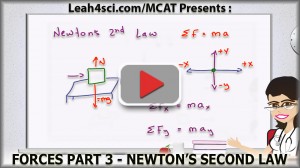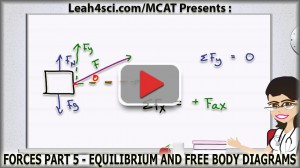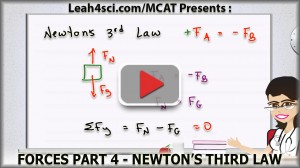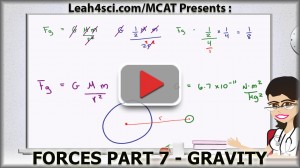 When it comes to forces in MCAT physics, you have to do more than simply memorize a bunch of equations. You need to set your goal on logic and understanding, being able to derive one force equation from another, AND being able to connect force equations to other MCAT topics including kinematics, work, energy and more.
When it comes to forces in MCAT physics, you have to do more than simply memorize a bunch of equations. You need to set your goal on logic and understanding, being able to derive one force equation from another, AND being able to connect force equations to other MCAT topics including kinematics, work, energy and more.
As an MCAT tutor, I find that, when students master this in forces, they have an easier time connecting other topics.
My goal with this video series is to help you make sense of Newton's Laws and all the wacky force equations.
For extra guidance as you study these videos, be sure to download my MCAT Forces Cheat Sheet.
This series requires a foundation in non-calculator math and kinematics. For a quick refresher, be sure to watch my MCAT Math Without A Calculator video series and my MCAT Kinematics video series.
Video 1 – Introduction to Forces in MCAT Physics
 Every video series needs an introduction, and Forces in MCAT Physics is no different.
Every video series needs an introduction, and Forces in MCAT Physics is no different.
This video introduces forces along with the proper way to derive units and ‘memorize' equations.
This video also shows you how to relate the kinematic equations to forces to ensure you don't mentally isolate the different topics.
Video 2 – Newton's First Law
Newton's First Law is more than just an explanation of inertia.
For the MCAT you will be required to UNDERSTAND and apply inertia concepts to bigger picture questions and passages.
This includes understanding inertia for objects at rest or in motion, and objects in motion changing their direction.
Video 3 – Newton's Second Law
 Newton's Second Law talks about how the sum of forces results in an acceleration.
Newton's Second Law talks about how the sum of forces results in an acceleration.
This video breaks down the F=ma concept by looking at the sum in the x direction, y direction, and some component between the 2 axis.
Video 4 – Newton's Third Law
Newton's third law of motion is potentially the most difficult to grasp. Fa = -Fb.
This video breaks it down to help you understand how a force can ‘magically' change to balance a counter-force.
Video 5 – Force Equilibrium and Free Body Diagrams
 When it comes to static or dynamic equilibrium, it's important that you understand how to visualize forces in every direction.
When it comes to static or dynamic equilibrium, it's important that you understand how to visualize forces in every direction.
This video shows you how to set up free body diagrams and then to set up a simplified equation to help you minimize time wasted on potentially complex MCAT questions.
Video 6 – Normal Force
This video explains the concept of Normal Force and shows you how to apply it to MCAT-style questions when objects are resting on horizontal surfaces, under a surface, and even on an inclined plane.
Video 7 – Gravitational Force
We tend to take the force of gravity for granted and, on the MCAT, you might see questions that ask you to calculate the gravitational pull on an object under very specific circumstances.
This video will show you how to calculate the force of gravity for objects near the surface of earth AND for objects far from earth, using both the simple and complex equations for gravity.
Video 8 – Static and Kinetic Friction
This video defines the forces of static and kinetic friction using real-life examples and shows you how to draw free body diagrams that incorporate friction, for both objects in motion and objects that are stationary, on a flat surface. You’ll also learn about the coefficient of static and kinetic friction. Plus, I'll walk you through a full-length practice problem.
Additional Force videos to follow include:
- Tension
- Centripetal Force
- Torque (not a force but worth studying)





